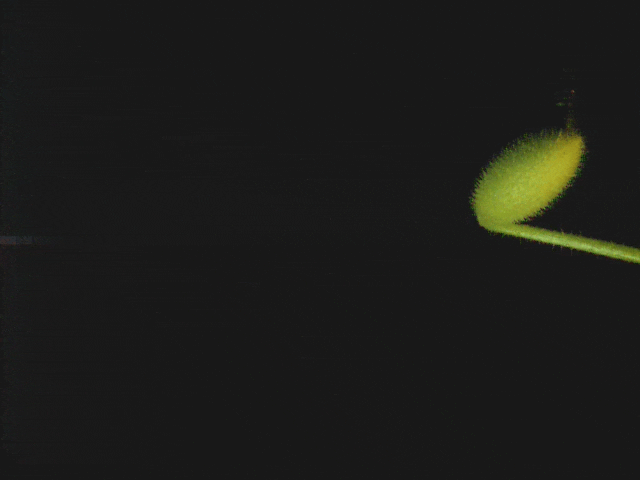The squirting cucumber Ecballium—not to be confused with the exploding cucumber Cyclanthera—is not a showy plant. It meanders on a vine on the ground, sprouting craggly green leaves and demure yellow flowers. Neither are Ecballium's fruits memorable to look at; the pale, bristly green pods are around the size of erasers and dangle glumly off their stems. But once ripe, the fruits will burst at a single touch, jettisoning a gloppy stream of seeds that can reach speeds of nearly 45 miles per hour and land 30 feet away from the plant. Today, a new paper in Proceedings of the National Academy of Sciences explains the mechanisms behind the squirting cucumber's fine-tuned ballistics.
The seeds of the paper were sown in the summer of 2022, when Chris Thorogood, the head of science at the Oxford Botanic Garden and an author on the paper, brought three mathematicians and one physicist to an unassuming patch of cucumbers. "Cucumbers aren’t normally very interesting," Derek Moulton, an applied mathematician at the University of Oxford and an author on the paper, wrote in an email. When Thorogood bent down to squeeze a fruit, "you could hear a tiny little squirt," Moulton said. But no one actually saw anything, leading Moulton to assume the squeezed cucumber was a dud.

But the squirting cucumber's squirt happens faster than the blink of an eye. Thorogood snipped the stems of some cucumbers to bring intact fruits back to the lab to film them with high-speed cameras, and researchers watched as the gourds spurted their seeds in slow-motion. "It was amazing," Moulton said. "We were hooked, and we wanted to understand it."
The squirting cucumber is far from the only explosive plant: hairy bittercress, Mexican petunias, and Impatiens, also known as "touch-me-nots," all shoot out seeds like ballistics. But Ecballium is an rather storied gourd. It was described by the Roman author and naturalist Pliny the Elder, who warned "the seed is apt to [spurt] out and be productive of danger to the eyes." The name Ecballium is derived from the Greek verb "to expel, throw, or cast out." According to the Oxford Herbaria, the squirting cucumber was once used as a drug to induce abortion, and may appear as an easter egg in Sandro Botticelli's sensuous painting Venus and Mars, held in the hand of a puckish satyr.

Each squirting cucumber contains around 50 oval seeds soaking in a mucilaginous fluid. The stem of an underripe cucumber droops over, seemingly from the heft of the fruit. But as a cucumber ripens, its stem stiffens and changes the orientation of the fruit, from hanging almost vertically to sticking out at a 45-degree angle. "Everyone learns in high school physics that if you want to fire something far, you need to fire close to 45 degrees, and somehow Ecballium manages to find that good firing angle," Moulton said.
The researchers first assumed the stem must be sucking up additional water to become stiff and pressurized, Moulton said. But the researchers experiments revealed the mass of the fruit and stem did not change during the ripening process. So the cucumber does not gain any new fluid, but rather redistributes it from the fruit to the stem. "That event is quite unusual in the animal kingdom, and really shows how well orchestrated the whole thing is," he added.
Once at its primed 45-degree firing angle, the cucumber will squirt at the slightest squeeze. And at this moment of ejection, "the stem starts to recoil, because it no longer has to bear the weight of the fruit," Moulton said. As the cucumber and stem begin to break apart, the tip of the stem rotates away from the cucumber, which creates a counter rotation in the cucumber. "That turns out to be important, as it changes the angle that each seed is ejected, leading to a better spread of seed," Moulton said. So the cucumber sends its seeds off in a kind of spiral, ensuring the seeds are spread far and wide and thus granted the best chance at growing up.
To create a mathematical model of the squirting cucumber, Moulton said the researchers needed to break the squirting apart into distinct components: the pressure in the fruit, how the pressurized fluid ejects into a stream, the interaction between the stem and the fruit leading up to the launch, the recoil of the stem and the counter-rotation of the fruit, and the ballistic trajectory of each seed. First, the researchers developed mathematical descriptions of each of these components. Then they linked them together to simulate the entire process, from overripe fruit to squirting seeds. The researchers relied on the experiments with real cucumbers to ensure the modelling was accurate.
"After doing all that though, the fun thing is that you now have a mathematical fruit and stem that you can play with," Moulton said. "And so a big part of our analysis was artificially changing various things in the model, creating a sort of mathematical mutant, and then asking how well the mutants disperse their seeds." But these hypothetical mutants only served to showcase Ecballium's squirting prowess; tinkering with these components invariably created less efficient squirters.
The researchers still have questions for the squirting cucumber, such as what mechanisms move the fluid from the fruit to the stem. But Moulton said he was "quite happy just to be able to uncover something about the mechanism of this fascinating little cucumber," as well as shine a light on the feats of plants. "They don't always get the attention that I think they deserve," Moulton said.






